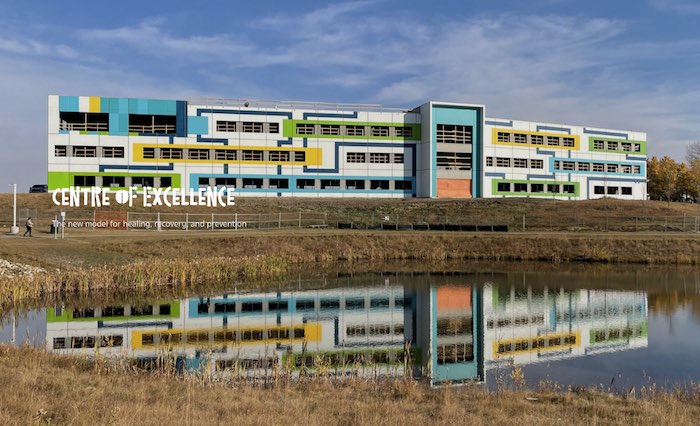Health
CACAC Enters Sprint for Final Million in Public Fundraising

The Central Alberta Child Advocacy Centre (CACAC) has hit a major milestone in public fundraising.
The new Sheldon Kennedy Centre of Excellence (SKCOE), a project started by the CACAC, is nearly complete. The building, situated on the Main Campus of Red Deer Polytechnic (RDP), has entered the final stage of completion. Along with construction milestones, the CACAC has also hit a major fundraising milestone, having raised $11.65 million of the $12 million dollar public fundraising goal set last year.
“We stand on the cusp of something truly remarkable,” says CACAC CEO Mark Jones. “We’re witnessing what happens when a community comes together in support of vulnerable children and youths in Central Alberta. We’re asking the public to help us through this final sprint to the finish line. Become a Champion of Courage – donate today to help us create lasting change.”
The SKCOE is currently home to the CACAC, the Central Alberta Sexual Assault Support Centre, and the newly-named MNP Move Your Mood Studio. Alberta Health Services’ Mental Health Outpatient Clinic is set to move in soon to the recently-named Lindsey More Youth Mental Health and Addiction hub on the second floor, and AHS’ Step Up Step Down program will move in on floor one. The new building triples capacity for Step Up Step Down, and brings unique and much-needed mental health services to Central Alberta. The SKCOE boasts more than forty mental health therapy rooms, and the connection with RDP allows for greater research and development.
“This facility is going to make a huge impact on generations of Albertans,” says Jones. “Thanks to this generous community, we have been able to get to where we are today. With one last push, we can cross the finish line. Every donation made, even five dollars, pushes us closer to being able to build a future of hope for those who require not just our services at the CACAC, but the varied services from all of our partners in the Sheldon Kennedy Centre of Excellence.”
The CACAC has also announced that they plan to do a public Grand Opening event some time in May, and encourages people to keep an eye on their website and social media platforms to keep up to date. To learn more about the Sheldon Kennedy Centre of Excellence, and to donate, visit https://www.centralalbertacac.ca/centre-of-excellence/
About CACAC: The Central Alberta Child Advocacy Centre is a not-for-profit organization rooted in the protection and recovery of today’s most innocent and vulnerable – our children. The Centre is comprised of a collective that is driven by the courage to support children, youth, and their families affected by abuse, enabling them to build enduring strength and overcome adversity. We work in a collaborative partnership with the Alberta Children and Family Services, Alberta Health Services, Alberta Justice, Alberta Education, Red Deer Polytechnic, the Central Alberta Sexual Assault Support Centre and the RCMP. Together we harness our collective courage to provide children with supported recovery.
For more information on CACAC, please visit: centralalbertacac.ca
Fraser Institute
Long waits for health care hit Canadians in their pocketbooks

From the Fraser Institute
Canadians continue to endure long wait times for health care. And while waiting for care can obviously be detrimental to your health and wellbeing, it can also hurt your pocketbook.
In 2024, the latest year of available data, the median wait—from referral by a family doctor to treatment by a specialist—was 30 weeks (including 15 weeks waiting for treatment after seeing a specialist). And last year, an estimated 1.5 million Canadians were waiting for care.
It’s no wonder Canadians are frustrated with the current state of health care.
Again, long waits for care adversely impact patients in many different ways including physical pain, psychological distress and worsened treatment outcomes as lengthy waits can make the treatment of some problems more difficult. There’s also a less-talked about consequence—the impact of health-care waits on the ability of patients to participate in day-to-day life, work and earn a living.
According to a recent study published by the Fraser Institute, wait times for non-emergency surgery cost Canadian patients $5.2 billion in lost wages in 2024. That’s about $3,300 for each of the 1.5 million patients waiting for care. Crucially, this estimate only considers time at work. After also accounting for free time outside of work, the cost increases to $15.9 billion or more than $10,200 per person.
Of course, some advocates of the health-care status quo argue that long waits for care remain a necessary trade-off to ensure all Canadians receive universal health-care coverage. But the experience of many high-income countries with universal health care shows the opposite.
Despite Canada ranking among the highest spenders (4th of 31 countries) on health care (as a percentage of its economy) among other developed countries with universal health care, we consistently rank among the bottom for the number of doctors, hospital beds, MRIs and CT scanners. Canada also has one of the worst records on access to timely health care.
So what do these other countries do differently than Canada? In short, they embrace the private sector as a partner in providing universal care.
Australia, for instance, spends less on health care (again, as a percentage of its economy) than Canada, yet the percentage of patients in Australia (33.1 per cent) who report waiting more than two months for non-emergency surgery was much higher in Canada (58.3 per cent). Unlike in Canada, Australian patients can choose to receive non-emergency surgery in either a private or public hospital. In 2021/22, 58.6 per cent of non-emergency surgeries in Australia were performed in private hospitals.
But we don’t need to look abroad for evidence that the private sector can help reduce wait times by delivering publicly-funded care. From 2010 to 2014, the Saskatchewan government, among other policies, contracted out publicly-funded surgeries to private clinics and lowered the province’s median wait time from one of the longest in the country (26.5 weeks in 2010) to one of the shortest (14.2 weeks in 2014). The initiative also reduced the average cost of procedures by 26 per cent.
Canadians are waiting longer than ever for health care, and the economic costs of these waits have never been higher. Until policymakers have the courage to enact genuine reform, based in part on more successful universal health-care systems, this status quo will continue to cost Canadian patients.
Health
Just 3 Days Left to Win the Dream Home of a Lifetime!

|
|
|
|
|
-

 International1 day ago
International1 day agoIsrael’s Decapitation Strike on Iran Reverberates Across Global Flashpoints
-

 National2 days ago
National2 days agoCarney promotes MP instrumental in freezing Freedom Convoy donors’ bank accounts
-

 Business2 days ago
Business2 days agoTrump: ‘Changes are coming’ to aggressive immigration policy after business complaints
-

 illegal immigration2 days ago
illegal immigration2 days agoLA protests continue as judge pulls back CA National Guard ahead of ‘No Kings Day’
-

 International2 days ago
International2 days agoPentagon agency to simulate lockdowns, mass vaccinations, public compliance messaging
-

 conflict2 days ago
conflict2 days agoIsrael strikes Iran, targeting nuclear sites; U.S. not involved in attack
-

 Alberta1 day ago
Alberta1 day agoPunishing Alberta Oil Production: The Divisive Effect of Policies For Carney’s “Decarbonized Oil”
-

 Alberta1 day ago
Alberta1 day agoAlberta Premier Danielle Smith Discusses Moving Energy Forward at the Global Energy Show in Calgary













